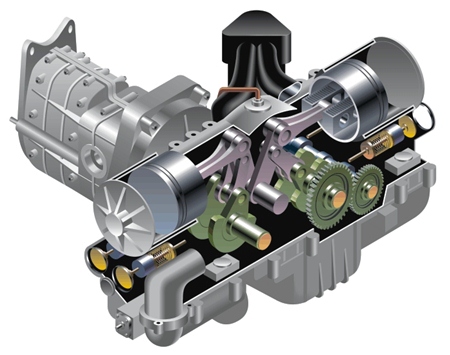French car conglomerate PSA Peugeot Citroen is showcasing a set of bold future technologies including a hybrid drivetrain that uses compressed air rather than batteries to store energy and will become production reality in 2016.
Now, the compressed air idea has been around for a while too, even advertised in an inventions magazine in 1928. However, as recently as 2000, CNN reported on a Korean company that had created a car engine that ran on air. The engine, which powers a pneumatic-hybrid electric vehicle (PHEV), works alongside an electric motor to create the energy source. The compressed air drives the pistons, which turn the vehicle’s wheels. The air is compressed using a small motor, powered by a 48 volt battery, which powers both the air compressor and the electric motor. Once compressed, the air is stored in a tank.
 Blow up here.
Blow up here.
The manufacturer also said the compressed air system could reduce the cost of vehicle production by about 20 percent, because there was no need to build a cooling system, fuel tank, spark plugs or silencers.
Round about the same time, a French company (MDI), and called Zero Pollution Motors in South Africa, produced a two cylinder compressed air engine. They called the vehicle they installed it in, the e.Volution, and even showed it at South African Auto show in 2000, and again at the Paris show in 2002. The cars generated much interest at the time, and the Mexican government was purportedly signing a deal to buy 40,000 e.Volutions to replace gasoline and diesel-powered taxis in the heavily polluted Mexico City.
The claims for e.Volution were quite substantial. It would travel for 200 km before needing another charge of compressed air. The e.Volution was powered by a two-cylinder, compressed-air engine. The basic concept behind the engine was unique in that it could run either on compressed air alone or act as an internal combustion engine. Dual fuel capabilities.
The compressed air was stored in carbon or glass fiber tanks at a pressure of 300 bar. This air was fed through an air injector to the engine and flows into a small chamber, which expands the air. The air pushing down on the pistons moves the crankshaft, which gives the vehicle power, very similar to the way burning fuel pushes down on the pistons to move the crankshaft in internal combustion engines.
Air tanks fixed to the underside of the vehicle can hold about 300 litres of air. When your air tank nears empty, you can just pull over and fill the e.Volution up at the nearest air pump. Using a household electrical source, it takes about four hours to refill the compressed air tanks. Well, that was the theory anyway.
Come today, and among the exhibits at the PSA Innovation day, held at its research and development center on the south-western fringe of Paris, was the company’s new modular global platform and a low-cost diesel-electric mild hybrid system that will feature on production cars from 2017.
The Hybrid Air system was developed with Bosch, which has experience in hydraulic energy recovery and traction systems for heavy trucks, and is claimed to deliver fuel savings of up to 45 percent in city driving or 35 percent overall.
A hydraulic pump powered by regenerative braking, or the petrol engine, stores the energy as compressed air in a cylinder in the car’s transmission tunnel.
The stored energy is later used to power a hydraulic motor that drives the wheels through the car’s transmission.
In zero-emissions mode, which PSA says runs for 80 percent of urban driving but has not indicated a maximum driving range, the petrol engine switches off and the hydraulic motor alone drives the wheels at up to 70 km/h.
PSA says Hybrid Air makes full hybrid technology more affordable, the pressure accumulators do not eat into interior space, and as a mechanical system it is reliable, robust and easy to maintain.
Quite frankly, I cannot see this compressed air system working. With the limited size of a tank that can fit in the transmission tunnel, it will not propel a car any decent distance. I think PSA are huffing and puffing, to be honest.




